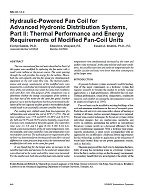Description
The two conventional fan-coil units described in Part I of this paper were modified by replacing the fan motor with a small water turbine as the power source. The water passing through the coil provides the energy for the turbine. Hence, both the coil capacity and the fan speed are simultaneously dependent on the coil water flow rate. The thermal performance and energy requirements of the modified units were measured in a controlled environment rig and compared with those of the conventional ones under the same inlet conditions and water flow rate. One purpose of the comparison was to determine whether the energy consumption of the turbine is less than that of the motor for the same fan speed. Another purpose was to test the hypothesis that the synchronized modulation of the coil capacity and fan speed in the modified design would result in an essentially constant sensible heat ratio. For cooling tests, chilled water from the evaporator of a refrigeration unit entered the coil at 45°F (7.22°C). The air inlet conditions were 75°F and 80°F (23.89°C and 26.67°C) dry bulb and 54.9% and 50.8% relative humidity, respectively. The tests were conducted at three fan speeds. The water flow rates were 2.5, 3.0, and 3.5 gpm (0.158, 0.189, 0.221 L/s). Steady-state measurements of the air outlet temperature, relative humidity, and water outlet flow rate and temperature were recorded for each test. The hydraulic power requirement of the turbine was determined from the measured water flow rate and difference in water pressure drop across the conventional and modified fan-coil units at the same fan speed. It was found that for the larger units, an increase in the sensible heat ratio and decrease in the outlet air temperature were observed as the water and airflow rates were increased. For the smaller unit, both the sensible heat ratio and air outlet temperature were simultaneously increased as the water and airflow rates increased. At the same inlet air and water condi-tions, the sensible heat ratio and outlet air temperature for the smaller size fan-coil units were lower than their counterparts of the larger units.
Units: Dual
Citation: Symposium, ASHRAE Transactions, vol. 106, pt. 2
Product Details
- Published:
- 2000
- Number of Pages:
- 9
- File Size:
- 1 file , 430 KB
- Product Code(s):
- D-7284




